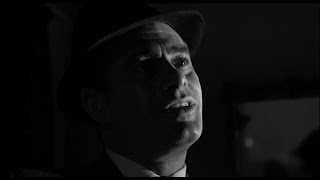
Did you spend the night with her? (The Bates Motel's foyer is as ingeniously dark as its bathrooms are light.)
What would we think of Hitchcock if he'd died immediately after completing Strangers on a Train in 1951? (Compare: what would we think of Shakespeare if he'd died right before Hamlet and the Globe in 1599?) Well, he'd have directed (at least) six bona fide classics (39 Steps, Lady Vanishes, Rebecca, Shadow of a Doubt, Notorious, and Strangers), and he'd have a second tier of very successful films (at least Suspicion, Foreign Correspondent, Spellbound, Saboteur, and Lifeboat) that most directors would kill for. Truncated Hitchcock would already have done enough to be the model for (Hitchcock regular) Leo G. Carroll's 'difficult', English film director, Henry Whitfield in Minnelli's The Bad and the Beautiful (1952), and he would almost certainly be revered today as a very important director, comparable to, say, Murnau, Lang, Lubitsch, McCarey, Capra, or Sturges.
What truncated Hitchcock wouldn't be, however, is Alfred Hitchcock Superstar, the figure who emerged both artistically and in a more general, cultural sense throughout the rest of the 1950s. The core of Hitchcock's monumental achievement after 1951 is two-fold. On the one hand, he produced and directed the run of great films from Rear Window through Marnie, which is one of the glories of cinema: a body of intensely personal expression that's also big studio system film-making at its finest. On the other hand, he became an important player in early television. Alfred Hitchcock Presents, which is still widely parodied, made Hitchcock's droll persona a weekly presence in people's homes for 10 years from 1955 (and ever after in syndication), and spurred a franchising empire second only to Disney's, that reached into every dime-store (Alfred Hitchcock's Mystery Magazine from 1956) and playground (Alfred Hitchcock and the Three Investigators from 1964).
In sum, after 1951, while in his own 50s, Hitchcock found an extra artistic gear, and also became the only true multi-media, director-star since DeMille. These two aspects of Alfred Hitchcock Superstar burn brightest, feeding each other, in Psycho, whose fiftieth anniversary we celebrate this year. Filmed cheaply in b&w, largely with Hitchcock's TV crew (except for three key film personnel: Tomasini, Herrmann, and Bass), and sold personally by Hitchcock as a direct extension of his TV persona (the trailer expands an arch Presents introduction into a six minute shaggy dog tale), Psycho was a taboo-shattering, culture-bending sensation (Mad Men's yesterday's man, Roger Sterling: 'Did you see that ridiculous Psycho? Hollywood isn't happy unless things are extreme.'). It was a punk chamber piece (literally - Herrmann's famous score used only strings) that was all the more potent for coming hot on the heels of North by Northwest's luxe romp. It also made Hitchcock fabulously rich: with a 60% share of profits, he cleared $15 million (~ add a zero to adjust for inflation).
Hitchcock's timing was perfect: he was top dog in Hollywood at the apex of US power in world GDP share terms, when the US was maximally glamorous and interesting to the rest of the world and probably to itself. Hitchcock did finally fall behind the times in the second half of the 1960s (and of his own 60s), but he made a storming comeback in the heart of the hard-R 1970s with Frenzy. Alfred Hitchcock Superstar's masterpieces therefore stretch from the Capra-Cukor-Ford 1930s golden age to the salad days of the 'movie brats'. Hitchcock is a one man history of 20th Century film, from pre-Code silents to the furtherest-out that mainstream film ever went or could ever go.
If it doesn't gel, it isn't aspic, but join me now in seeing how the great man, his superstar-dom, his influences, and his influence have congealed on-line. You might fool me, but I wouldn't recommend trying to fool my mother.
1) Hitchcock in high spirits on What's My Line? just after Rear Window's release. He signs in not just with his name but also with his profile caricature, perhaps shrewdly pre-marketing his TV show for the following year.
2) The best onscreen kiss since Grant and Bergman's in Notorious. Hitchcock in his pomp feasts at the true top-table of stars-who-made-Hollywood. The master of suspense is also a master of romance.
3) Three stars, the cream of collaborators behind the camera, and an apex of personal branding for Hitchcock as he makes one of his most forceful cameos underneath his director credit. Top dog.
4) Into the shower. There had never been anything like it. The blood that flows toward the drain comes in pulses. We orbit an eye the size of a space-station. Janet Leigh's magnificent face-down plant into the bathroom floor remains the only convincing still-warm, dead body in movie history.
5) Frenzy unsparingly depicts Brenda Blaney's murder and rape, but leaves the next victim, Babs's demise to our imaginations. We imagine it beforehand as we track backwards ahead of Babs and her murderer walking blithely to her doom, and we imagine it afterwards (or as it's actually happening) as the camera retreats down the murderer's stairs, out of the building and across the street. It's Noe's Irreversible coming and Haneke's Funny Games going.
No comments:
Post a Comment